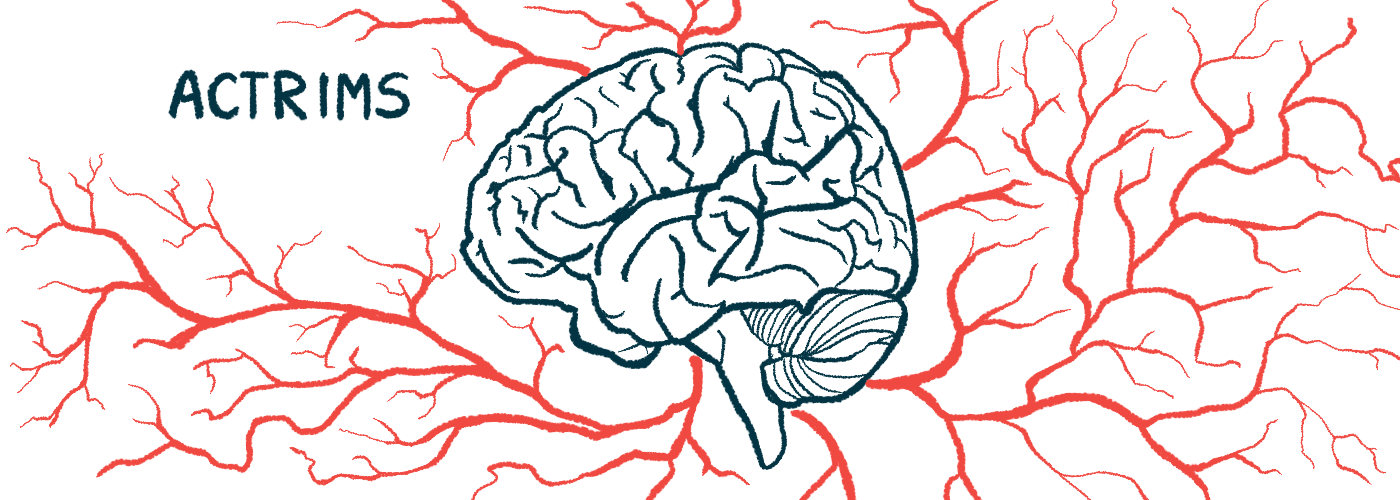ACTRIMS 2023: CNM-Au8 bound for Phase 3 testing after positive data
Positive results could support applications for the therapy's regulatory approvals
Written by |

Treatment with the experimental oral suspension therapy CNM-Au8 led to improvements in measures of vision, cognitive and motor function, and brain health for people with multiple sclerosis (MS), according to data from the proof-of-concept VISIONARY-MS trial.
Bolstered by these positive results, Clene Nanomedicine is planning to launch a global Phase 3 clinical trial to further evaluate its effectiveness in MS. Assuming the results are positive, Clene expects they could support applications for CNM-Au8’s regulatory approvals, according to Michael Hotchkin, the company’s chief development officer.

Michael Hotchkin, chief development officer at Clene Nanomedicine
“We’re working with a team of leading clinical advisors still coming up with a protocol design for the Phase 3 [trial],” Hotchkin said in an interview with Multiple Sclerosis News Today during the Americas Committee for Treatment and Research in Multiple Sclerosis (ACTRIMS) Forum 2023.
“We’re also in dialogue with both FDA [U.S. Food and Drug Administration] and EMA [European Medicines Agency], with ongoing discussions on what that Phase 3 design ought to look like and what they’ll consider is clinically acceptable,” Hotchkin said. “Our goal is to have that study kicked off by the end of the year. It may be an optimistic goal, but that’s still a goal.”
The upcoming trial will test CNM-Au8’s effect on disease progression that occurs independently of relapse activity, when symptoms suddenly flare up. Though he emphasized that its design is still being developed, Hotchkin said the study will most likely enroll people with nonactive, progressive types of MS — people with primary progressive or secondary progressive disease who haven’t had a relapse in at least a year.
While there are more than a dozen disease-modifying therapies approved to treat relapsing types of MS, nonrelapsing forms have proven much more challenging to treat.
Hotchkin said the trial may include people with relapsing MS who’ve had progression independent of relapse activity. “But that’s still an ongoing debate with our advisors,” he said.
Boosting energy, a new mechanism of action for MS therapies
CNM-Au8 is an oral liquid therapy that contains a suspension of gold nanoparticles. It’s designed to boost energy production in cells.
“What we found in all of the early research we do, which is … done in animals or test tubes, is that when we’re able to boost the energetic capacity or energetic production of neurons [nerve cells], they can withstand diseases and different insults much more readily,” Hotchkin said. “Across a variety of different models, we were able to show that the application of CNM-Au8 to different neurons and different cultures always kept them alive longer, and it’s that energetic assist that we think helps them resist different diseases.”
Hotchkin said this energy boost only appears to have an effect on diseased cells.
“If we treat healthy neurons, nothing happens. If we treat diseased neurons that have some sort of energetic deficit, that’s when we see all kinds of protection and preservation,” he said.
The energy-boosting mechanism of CNM-Au8 sets it apart from approved MS therapies, all of which work by diminishing the inflammatory attack that drives MS. Blocking MS inflammatory activity generally helps prevent disease relapses, but the effect on progression that occurs without relapse activity is generally less robust.
“Current standard of care … tamps down that relapse relapse activity. But many patients still have what’s called progression independent of relapse activity or ongoing progression that isn’t an acute relapse,” Hotchkin said. “What we’ll do [in the upcoming Phase 3 trial] is investigate whether CNM-Au8 can slow that progression independent of relapse activity.”
VISIONARY-MS results: improved vision and brain structure health
After early clinical testing suggested CNM-Au8 could boost energy in nerve cells as designed, Clene launched the Phase 2 VISIONARY-MS trial (NCT03536559) as a proof-of-concept to test the therapy’s effectiveness in MS.
The trial enrolled people with relapsing-remitting multiple sclerosis (RRMS) who had stable disease, meaning they hadn’t had a relapse in at least six months before entering it. “Many of them hadn’t had relapses in four to five years,” Hotchkin said.
The participants were randomly assigned to receive one of two doses of CNM-Au8 — 15 mg or 30 mg daily — or a placebo, daily for 48 weeks (nearly a year).
More than 90% of the patients were on immune-suppressing therapies, most commonly (53%) monoclonal antibody infusion medications such as Ocrevus (ocrelizumab), Tysabri (natalizumab), or rituximab. Another 32% were receiving “highly effective oral therapies,” such as Gilenya (fingolimod) and Tecfidera (dimethyl fumarate).
“We wanted to have a relapse-free patient population, so we studied [CNM-Au8] in early relapsing patients on top of background care to test whether CNM-Au8 can actually improve clinical function in people living with MS,” Hotchkin said.
VISIONARY-MS specifically enrolled RRMS patients with chronic optic neuropathy — damage to the nerves that relay data from the eyes to vision-processing centers in the brain, resulting in problems with vision. Its main goal was to assess the effect of treatment on low contrast letter acuity, or LCLA.
LCLA tests are similar to the common test an optometrist or ophthalmologist performs where a patient read lines of increasingly small letters. But, whereas the standard form of this test uses black letters on a white background, the LCLA uses fainter gray letters.
“For MS patients, many of them lose the ability to do edge detection or contrast detection. So instead of that black and white eye chart, we used … gray letters on white,” Hotchkin said. “And then we counted the number of letters that the people in the study could read before they started the study and then after treatment every 12 weeks.”
Top-line results from the trial, announced last year, showed CNM-Au8 led to improvements in LCLA over a placebo by an average of about 3 points. This roughly corresponds to being able to read one additional line of letters in the LCLA test, according to Hotchkin.
CNM-Au8 also outperformed a placebo on measures of visual evoked potential, which assess the strength and speed of the nerve signals that carry data from the eyes to the brain. Although patients usually have one eye more affected by optic neuropathy than the other, improvements were observed in both eyes.
“What that implies is that neurons that were previously damaged or not contributing to that information processing are now able to contribute,” Hotchkin said.
That data was presented at ACTRIMS last week in San Diego by Benjamin Greenberg, MD, a professor of neurology and MS expert at the Southwestern Medical Center, Dallas. His poster was titled, “CNM-Au8 Phase 2 VISIONARY-MS Trial Results.”
“The newly released [visual evoked potential] data provide further evidence of neuronal preservation,” Greenberg said in a Clene press release. “Years have been spent seeking a truly neuroprotective therapy for multiple sclerosis and other neurodegenerative diseases. These data help build a strong case in favor of pursuing CNM-Au8 in further Phase 3 studies.”
Other data from VISIONARY-MS suggested CNM-Au8 helped stabilize brain structures and preserve the integrity of the myelin sheath, the fatty covering around nerve fibers that’s damaged in MS.
“Having preserved brain structure is a really good thing,” Hotchkin said, noting that placebo-treated patients tended to decline. He said improvements in myelin health were seen “all across the brain.”
“In every subset we studied, all [measures of myelin health] improved in favor of CNM-Au8, and we think that the chance of that being just a chance finding is remotely low, because everywhere they improve in the same direction, showing a benefit,” he said.
Functionality benefits with treatment
The VISIONARY-MS trial also used the modified Multiple Sclerosis Functional Composite (mMSFC) scale, a combined measure that includes LCLA (for vision) as well as walking ability, upper arm dexterity, and cognitive function.
Results showed mMSFC scores were significantly higher in patients given CNM-Au8 than a placebo, by an average of about 0.28 points.
“When we look at each [component of the mMSFC] individually, we saw improvements in obviously low contrast letter acuity, we saw improvements in cognition, we saw improvements in the nine-hole peg test [a measure of dexterity] in the dominant hand, and some trends toward improvements in walking,” Hotchkin said. “When we lump all of that together into this common numerical framework, we see an overall benefit where placebo patients had no change and CNM-Au8-treated patients did much better.” He said the numerical difference of 0.28 “is just the mathematical expression of collapsing all those skills together and saying, ‘did we see improvement or not?'”
Hotchkin said because MS affects everyone differently and the mMSFC measures multiple areas of functionality, its difficult to put this number in the context of what it would mean for an individual patient.
“When we do studies we talk about population means [to understand] what happened in the treatment arm, but … there are a lot of individual stories and patient experiences that are contained within those,” he said, noting some patients on CNM-Au8 reported having an easier time reading at night or having more energy during the day.
VISIONARY-MS originally planned to enroll 150 patients, but enrollment was cut at 73 participants, due to complications from the COVID-19 pandemic.
Fewer patients generally means a trial has less statistical power to detect a significant treatment effect. While analyses of the results were adjusted to account for the loss of statistical power, Hotchkin said the fact that significant results were seen even with a smaller than planned sample size speaks to the potential magnitude of the effect CNM-Au8 may have.
“The more effect you have, the fewer patients you need, as kind of a statistical truism. And here … we have these amazing results both on the clinical level and in the structural [and] functional level,” he said. “When we look at the totality of the evidence, all of them are mutually reinforcing that we had a treatment benefit and we’re really excited to take this on to a Phase 3 program.”
Note: The Multiple Sclerosis News Today team is providing in-depth coverage of the ACTRIMS Forum 2023 Feb. 23-25. Go here to see the latest stories from the conference. Follow along on Facebook, Twitter, and Instagram for live updates using the hashtag #actrims2023.





